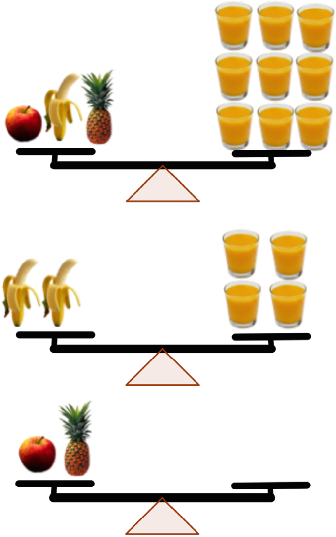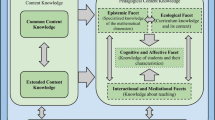Abstract
In this work the results of applying a questionnaire to assess didactic-mathematical knowledge of prospective secondary school teachers are analyzed. The sample consists of 31 students, prospective teachers, from the School of Teacher Training of Namibe in Angola. The questionnaire is made of 20 items that assess algebraic content and didactic content knowledge in secondary education. The quantitative analysis of the results show a low level of algebraic and didactic content knowledge and we conclude that it is necessary to improve the teacher training program to enable these teachers to develop the mathematics and didactic competences they need.


Similar content being viewed by others
References
Filloy, E., Puig, L., Rojano, T.: Educational algebra. A theoretical and empirical approach. Springer, New York (2008)
Godino, J.D.: Categorías de análisis de los conocimientos del profesor de matemáticas. UNIÓN, Revista Iberoamericana de Educación Matemática 20, 13–31 (2009)
Godino, J.D., Aké, L., Gonzato, M., Wilhelmi, M.R.: Niveles de algebrización de la actividad matemática escolar. Implicaciones para la formación de maestros. Enseñanza de las Ciencias 32(1), 199–219 (2014)
Godino, J.D., Neto, T., Wilhelmi, M.R., Aké, L., Etchegaray, S., Lasa, A.: Niveles de algebrización de las prácticas matemáticas escolares. Articulación de las perspectivas ontosemiótica y antropológica. Avances de Investigación en Educación Matemática 8, 117–142 (2015)
Godino, J.D., Wilhelmi, M.R., Neto, T., Blanco, T.F., Contreras, A., Díaz-Batanero, C., Estepa, A., Lasa, A.: Evaluación de conocimientos didáctico—matemáticos sobre razonamiento algebraico elemental de futuros maestros. Revista de Educación (2015). https://doi.org/10.4438/1988-592x-re-2015-370-303
Kaput, J.: What is algebra? What is algebraic reasoning? In: Kaput, J., Carraher, D.W., Blanton, M.L. (eds.) Algebra in the Early Grades, pp. 5–17. Routledge, New York (2008)
Kieran, K.: Learning and teaching algebra at the middle school through college levels: building meaning for symbols and their manipulation. In: Lester, F. (ed.) Second Handbook of Research on Mathematics Teaching and Learning, vol. 2, pp. 707–762. NCTM, Information Age Publishing, Charlotte (2007)
Shulman, L.S.: Knowledge and teaching: foundations of the new reform. Harv. Educ. Rev. 57(1), 1–22 (1987)
Author information
Authors and Affiliations
Corresponding author
Additional information
Publisher's Note
Springer Nature remains neutral with regard to jurisdictional claims in published maps and institutional affiliations.
Appendix
Appendix

Try to answer all the tasks and do not erase anything you write. If you think it is wrong, simply scratch the response.
- 1.
Observe the figure below:
- (a)
How many glasses have to put in the third balance to make it balanced?
- (b)
What interpretation of “balance” is associated with the situation? How would you explain to your pupils?

- (a)
- 2.
A pupil made the following conjecture: “I add three consecutive natural numbers. If I divide the result by three I always get the second number”.
- (a)
Is the statement valid for all natural numbers? Why?
- (b)
In your opinion, what kind of justification could a primary school pupil give to this conjecture?
- (a)
- 3.
Consider the following sequence of figures.

- (a)
Determine the number of dots that the shape placed on the twenty-fifth (25th) position of this sequence will have, assuming it continues with the same rule of formation. Justify your answer.
- (b)
Indicate the techniques or different ways in which the problem can be solved.
- (c)
Do you consider that this task could be proposed to pupils in the basic school? How could they reach a solution?
- (a)
- 4.
An “Economic” taxi company launch a fare campaign during the summer holidays. For a taxi ride, a flat fee is charged 530 (Kwanza) and more 170 (Kwanza) by kilometer up to a distance of 5 km; and 70 (Kwanza) by kilometers after 5 km of distance. A taxi driver is willing to wait if a passenger wants to stop before continuing his journey and charges 350 (Kwanza) for 10 min of waiting.
- (a)
What is the amount to pay on a trip of 4 km? And 8 km?
- (b)
What is the distance of the trip, if a taxi driver receives from 2600 (Kwanza) with 20 min of waiting?
- (c)
Do you consider that this task can be proposed to pupils of the 8th Class? How could you approach the resolution with these pupils?
- (a)
- 5.
Analyze the following expressions:
- 1.
4x + 5 = 25.
- 2.
y = 2x +1.
- 3.
P = 2c + 2l.
- 1.
- (a)
Describe your interpretation of each of the above expressions.
- (b)
Come up with three problems that may be proposed to pupils and whose solution leads to these expressions.
- 6.
To fill a container with a maximum capacity of 90 L with water a faucet whose flow is constant and equal to 18 L per minute is used.
- (a)
Indicate which of the three graphical representations corresponds to the situation described above, being that the X axis represents time in minutes and the Y axis the volume of water in liters.
- (a)

Answer: _____; Justification:
- (b)
What mathematical knowledge or other type of knowledge is used to solve this task?
- (c)
Do you consider that this task could be given to basic school pupils? If so, what level? Justify your answers.
- 7.
Consider the general form of a system of linear equations with two unknowns.
$$ \left\{ {\begin{array}{*{20}l} {a_{1 } x + b_{1} y = c_{1} } \hfill \\ {a_{2 } x + b_{2} y = c_{2} .} \hfill \\ \end{array} } \right. $$- (a)
Design two problems that can be proposed to students of the 8th Class involving the solution of a system of linear equations with two unknowns.
- (b)
Solve them by the method that is considered most appropriate for the 8th Class.
- (a)
- 8.
Consider the family of quadratic functions defined by the expression \( y = ax^{2} \).
Analyze the behavior of the functions distinguishing cases:
- (a)
Explain the effects of the parameter a in the graphs of these functions.
- (b)
Identify the algebraic knowledge that come into play in the solution, indicating the meanings of the literal symbols and the equality.
Rights and permissions
About this article
Cite this article
Neto, T.B., Kamuele, L. & de Natividade, M. Assessing the didactic and mathematical knowledge of prospective mathematics teachers in Namibe, Angola. Afr. Mat. 31, 155–165 (2020). https://doi.org/10.1007/s13370-019-00747-3
Received:
Accepted:
Published:
Issue Date:
DOI: https://doi.org/10.1007/s13370-019-00747-3
Keywords
- Didactic-mathematical knowledge
- Competences
- Teachers’ training
- Secondary school teachers
- Algebraic reasoning






